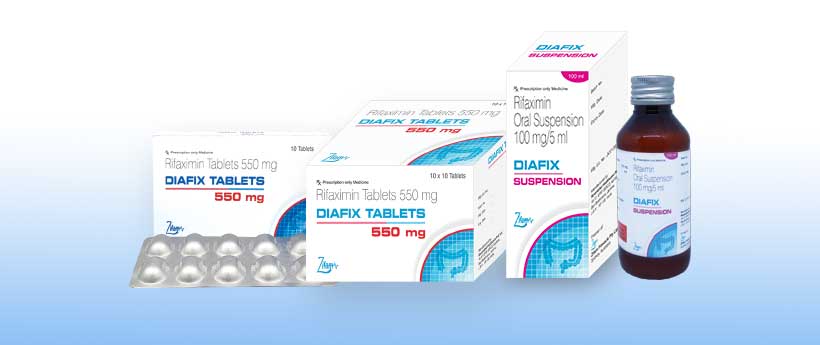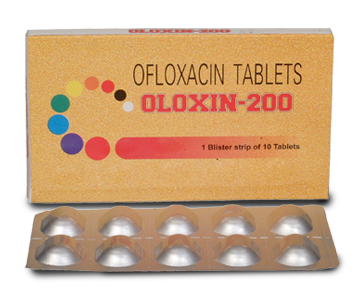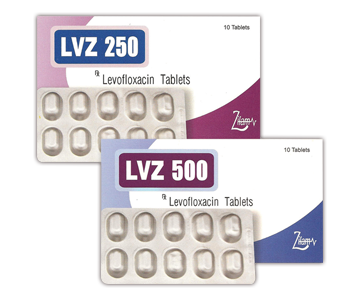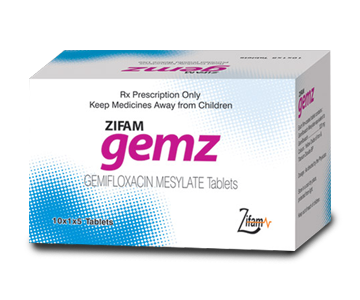Diafix 550mg/ Oral Suspension
- ENG
- မြန်မာ

DIAFIX
DIAFIX TABLETS 550 mg
(Rifaximin Tablets 550 mg)
COMPOSITION:
Each film coated tablet contains:
Rifaximin BP 550mg
Excipients q.s.
Colour: Approved colour used
DIAFIX ORALSUSPENSION
(Rifaximin Oral Suspension) 100mg/5ml)
COMPOSITION:
Each 5ml contains:
Rifaximin BP 100 mg
Excipients q.s.
INDICATIONS AND USES:
Rifaximin is a nonabsorbable rifamycin antibacterial indicated for:
- Acute and chronic intestinal infections sustained by gram-positive and gram-negative bacteria; diarrheic syndrome.
- Diarrhoea caused by an altered equilibrium of the intestinal microbial flora (summer diarrhoea, traveler’s diarrhea, enterocolitis).
- Reduction in risk of overt hepatic encephalopathy (HE) recurrence in adults.
- Treatment of irritable bowel syndrome with diarrhea (IBS-D) in adults.
PHARMACOLOGICAL ACTIONS:
Pharmacokinetic Properties
Absorption
Pharmacokinetic studies in rats, dogs and humans administration that after oral administration rifaximin in the polymorph a form is poorly absorbed (less than 1%). After repeated administration of therapeutic doses of rifaximin in healthy volunteers and patients with damaged intestinal mucosa (Inflammatory Bowel Disease), plasma levels are negligible (less than 10 ng/mL). In HE patients, administration of rifaximin 550 mg twice a day showed mean rifaximin exposure approximately 12-fold higher than that observed in healthy volunteers following the same dosing regimen. A clinically irrelevant increase of rifaximin systemic absorption was observed when administered within 30 minutes of a high-fat breakfast.
Distribution
Rifaximin is moderately bound to human plasma proteins. In vivo, the mean protein binding ratio was 67.5% in healthy subjects and 62% in patients with hepatic impairment when rifaximin 550 mg was administered.
Biotransformation
Analysis of fecal extracts demonstrated that rifaximin is found as the intact molecule, implying that it is neither degraded nor metabolized during its passage through the gastrointestinal tract.
In a study using radio-labelled rifaximin, urinary recovery of rifaximin was 0.025% of the administered dose, while <0.01% of the dose was recovered as 25-desacetylrifaximin, the only rifaximin metabolite that has been identified in humans.
Elimination
A study with radio-labelled rifaximin suggested that 14C-rifaximin is almost exclusively and completely excreted in faces (96.9 % of the administered dose). The urinary recovery of 14C-rifaximin does not exceed 0.4% of the administered dose.
Linearity/non-linearity
The rate and extent of systemic exposure of humans to rifaximin appeared to be characterized by non-linear (dose-dependent) kinetic which is consistent with the possibility of dissolution-rate-limited absorption of rifaximin.
Special Populations
Renal impairment
No clinical data are available on the use of rifaximin in patients with impaired renal function.
Hepatic impairment
Clinical data available for patients with hepatic impairment showed a systemic exposure higher than that observed in healthy subjects. The systemic exposure of rifaximin was about 10-, 13-, and 20-fold higher in those patients with mild (Child-Pugh A), moderate (Child-Pugh B), and severe (Child-Pugh C) hepatic impairment, respectively, compared to that in healthy volunteers. The increase in systemic exposure to rifaximin in subjects with hepatic impairment should be interpreted in light of rifaximin gastrointestinal local action and its low systemic bioavailability, as well as the available rifaximin safety data in subjects with cirrhosis.
Therefore no dosage adjustment is recommended because rifaximin is acting locally.
Mechanism of action
Rifaximin is an antibacterial agent of the rifamycin class that binds irreversibly to the beta sub-unit of the bacterial enzyme DNA-dependent RNA polymerase and consequently inhibits bacterial RNA synthesis.
Rifaximin has a broad antimicrobial spectrum against most of the Gram-positive and negative, aerobic and anaerobic bacteria, including ammonia producing species. Rifaximin may inhibit the division of urea-deaminating bacteria, thereby reducing the production of ammonia and other compounds that are believed to be important to the pathogenesis of hepatic encephalopathy.
Susceptibility
Rifaximin is a non-absorbed antibacterial agent. In vitro susceptibility testing cannot be used to reliably establish susceptibility or resistance of bacteria to rifaximin. There are currently insufficient data available to support the setting of a clinical breakpoint for susceptibility testing.
Rifaximin has been evaluated in vitro on several pathogens including ammonia producing bacteria as Escherichia coli spp, Clostridium spp, Enterobacteriaceae, Bacteroides spp. Due to the very low absorption from the gastro- intestinal tract rifaximin is not clinically effective against invasive pathogens, even though these bacteria are susceptible in vitro.
Clinical efficacy
The efficacy and safety of rifaximin 550 mg twice daily in adult patients in remission from HE was evaluated in a phase 3 pivotal, 6-month, randomized, double-blind, placebo-controlled stud FHE3001.
Two-hundred ninety-nine subjects were randomized to treatment with rifaximin 550 mg twice daily (n-140) or placebo (n- 159) for 6 months. In the pivotal study, 91% of the subjects in both groups received concomitant lactulose. No patients were enrolled with a MELD score > 25.
The primary endpoint was the time to first breakthrough overt HE episode and patients were withdrawn after a breakthrough overt HE episode. Thirty-one of 140 subjects (22%) of rifaximin group and 73 of 159 (46%) subjects of placebo group experienced a breakthrough overt HE episode during the 6-month period. Rifaximin reduced the risk of HE breakthrough by 58% (p« 0.0001) and the risk of HE-related hospitalizations by 50% (p<0.013), compared with placebo.
The longer-term safety and tolerability of rifaximin 550 mg twice daily administered for at least 24 months was evaluated in 322 subjects in remission from HE in study RFHE3002. One hundred fifty-two subjects rolled over from RHE3001 (70 from the rifaximin group and 82 from the placebo), and 170 subjects were new. Eighty-eight percent of patients were administered concomitant lactulose.
Treatment with rifaximin for periods up to 24 months (OLE study RHE3002) did not result in any loss of effect regarding the protection from breakthrough overt HE episodes and the reduction of the burden of hospitalization. Time to first breakthrough overt HE episode analysis showed long-term maintenance of remission in both groups of patients, new and continuing rifaximin.
Combination therapy with rifaximin and lactulose showed a statistically significant reduction in mortality in HE patients compared with lactulose alone in a systematic review and meta-analysis of four randomized and three observational studies involving 1822 patients (risk difference (RD) -0.11, 95% CI-0.19 to -0.03, P-0.009). Additional sensitivity analyses confirmed these results. Notably, a pooled analysis of two randomized trials – including 320 patients treated for up to 10 days and followed-up during hospitalization – demonstrated a statistically significant decrease in mortality (RD-0.22, 95% CI-0.33 to -0.12, P0.0001).
DOSAGE AND ADMINISTRATION:
Dosage for Travellers’ Diarrhea:
Adults: One 200 mg tablet 3 times a day for 3 days
Children over 12 years: One 200 mg tablet every 6 hours
Children from 6-12 years of age: Half to One 200 mg tablet every 6 hours
Children from 2-6 years of age: One teaspoonful (5 ml) of oral suspension every 6 hours
Dosage for Hepatic Encephalopathy:
The recommended dose is 550 mg tablet taken orally two times a day.
Dosage for Irritable Bowel Syndrome with Diarrhea
The recommended dose of 550 mg tablet taken orally three times a day for 14 days, Patients who experience a recurrence of symptoms can be retreated up to two times with the same dosage regimen.
Elderly
No dosage adjustment is necessary as the safety and efficacy data of 550 mg tablet showed no differences between the elderly and the younger patients.
Hepatic impairment
No dosage adjustment is necessary for patients with hepatic insufficiency.
Renal impairment
Although dosing change is not anticipated, caution should be used in patients with impaired renal function.
Method of administration
Rifaximin can be administered with or without food.
CONTRAINDICATIONS:
Hypersensitivity to the active substance, to any rifamycin derivatives (c.g rifampicin or rifabutin) or to any ofthe excipients.
Cases of intestinal obstruction
WARNINGS AND PRECAUTIONS:
Clinical data have shown that rifaximin is not effective in the treatment of travellers’ diarrhoes caused by invasive enteric pathogens such as Campylobacter jejuni, Salmonella spp. and Shigella, which typically produce dysentery like diarrhea characterized by fever, blood in the stool and high stool frequency.
If symptoms worsen treatment with rifaximin should be interrupted.
If symptoms have not resolved after 3 days of treatment, or recur shortly afterwards, a second course of rifaximin should not be administered Clostridium difficile associated diarrhea (CDAD) has been reported with use of nearly all antibacterial agents, including rifaximin. The potential association of rifaximin treatment with CDAD and pseudomembranous colitis (PMC) cannot be ruled out.
Patients should be informed that despite the negligible absorption of the drug (less than 1%), like all rifamycin derivatives, rifaximin may cause a reddish discoloration of the urine.
Caution should be exercised when concomitant use of rifaximin and a P-glycoprotein inhibitor such as ciclosporin is needed.
Both decreases and increases in international normalized ratio (in some cases with bleeding events) have been reported in patients maintained on warfarin and prescribed rifaximin. If co-administration is necessary, the international normalized ratio should be carefully monitored with the addition or withdrawal of treatment with rifaximin. Adjustments in the dose of oral anticoagulants may be necessary to maintain the desired level of anticoagulation.
Paediatric population
550 mg tablet is not recommended for use in children («18 years old).
Due to the lack of data and the potential for severe disruption of gut flora with unknown consequences, concomitant administration of rifaximin with other rifamycins is not recommended.
Patients should be informed that despite the negligible absorption of the drug (less than 196), like all rifamycin derivatives, rifaximin may cause a reddish discoloration of the urine.
Hepatic Impairment: use with caution in patients with severe (Child-Pugh C) hepatic impairment and in patients with MELD (Model for End-Stage Liver Disease) score > 25
OVERDOSE:
In clinical trials with patients suffering from travellers’ diarrhoea doses of up to 1800 mg/day have been tolerated without any severe clinical signs.
Dosages of up to 2400 mg/day for 7 days in patients/subjects with normal bacterial Sara rifaximin did not result in any relevant clinical symptoms related to the high dosage.
In case of overdose symptomatic treatments and supportive care are recommended.
ADVERSE REACTIONS:
Mast common adverse reactions:
Stop taking Rifaximin and tell your doctor IMMEDIATELY if you have any of the following side effects:
Uncommon: may affect up to 1 in 100 people.
- If you have bleeding from swollen blood vessels in your throat (esophageal varices).
- If you have severe diarrhoea during or after using this medicine. This may be due to an infection of the intestine.
Not known (frequency cannot be estimated from the available data) lf you get an allergic reaction, hypersensitivity or angioedema.
Symptoms include:
- swelling of the face, tongue or throat.
- swallowing difficulties.
- hives and breathing difficulties.
If you have any unexpected or unusual bleeding or bruising. This may be due to a decrease in the platelets in your blood which increases the risk of bleeding. Frequency is not known
Other side effects that may occur
Common (may affect up to I in 10 people): Depressed mood, Dizziness, Headache, Shortness of breath, Feeling or being sick, Stomach ache or bloating/swelling, Diarrhoea, Accumulation of fluid in the abdominal cavity (ascites), Rash or itching, Muscle cramps, Joint pain, Swelling of ankles, foot or fingers.
Uncommon (may affect up to 1 in 100 people: Yeast infections (such as thrush), Urinary infection (such as cystitis), Anemia (reduction in red blood cells which can make the akin pale and cause weakness or breathlessness), Loss of appetite, Hyperkalemia (high level of potassium in the blood), Confusion, Anxiety, Feeling sleepy, Difficulty sleeping, Feeling unsteady, Loss of or poor memory, Loss of concentration, Reduced sense of touch, Convulsions (fits), Hot flushes.
Rare (may affect up to 1 in 1,000 people): Chest infections including pneumonia, Cellulitis (inflammation of tissue under skin), Upper respiratory tract infections (nose, mouth, throat), Rhinitis (inflammation inside the nose), Dehydration (body water loss), Changes in blood pressure, Constant breathing problems (such as chronic bronchitis), Constipation, Back pain, Protein in the urine, Feeling weak, Bruising.
Pain following surgery.
Not known. (frequency cannot be estimated from the available data ; Fainting or feeling faint, Skin irritation, eczema (itchy, red, dry skin), Reduction in platelets (seen in the blood), Changes in the way the liver is working (seen in blood test), Changes in blood coagulation
(International Normalized Ratio seen in blood test).
Limitations of Use
Travellers’ Diarrhea: Do not use in patients with diarrhea complicated by fever or blood in the stool or diarrhea due to pathogens other than Escherichia coli
DRUG INTERACTIONS:
Use in Specific Populations
Pregnancy
There is no or limited data from the use of rifaximin in pregnant women.
Animal studies showed transient effects on ossification and skeletal variations in the foetus.
The clinical relevance of these findings in humans is unknown.
As a precautionary measure, use of rifaximin during pregnancy is not recommended.
Breastfeeding
It is unknown whether rifaximin/metabolites are excreted in human milk.
A risk to the breast-fed child cannot be excluded.
A decision must be made whether to discontinue breast-feeding or to discontinue/abstain from rifaximin therapy taking into account the benefit of breast feeding for the child and the benefit of therapy for the woman.
Fertility
Animal studies do not indicate direct or indirect harmful effects with respect to male and female fertility.
Effects on ability to drive and use machines
In clinical controlled trials dizziness and somnolence have been reported but rifaximin has negligible influence on the ability to drive and use machine
Storage:
Tablets: Store below 30 °C. Protect from light and moisture.
Oral Suspension: Store below 30 °C. Protect from direct sunlight.
Keep medicine away from children.
Packaging:
DIAFIX TABLETS 550 MG:
10 x 1 x 10 Tablets in a Alu-Alu blister pack.
10 × 10 Tablets in a Alu-Alu blister pack.
DIAFIX ORALSUSPENSION:
100ml Amber pet bottle packed in a unit carton.
Shelf life:-
24 Months from the date of manufacturing.








